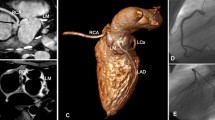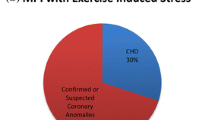Abstract
Background
Stress perfusion cardiovascular magnetic resonance (CMR) is used widely in adult ischemic heart disease, but data in children is limited. We sought to evaluate feasibility, accuracy and prognostic value of stress CMR in children with suspected coronary artery disease (CAD).
Methods
Stress CMR was reviewed from two pediatric centers over 5 years using a standard pharmacologic protocol. Wall motion abnormalities, perfusion deficits and late enhancement were correlated with coronary angiogram (CAG) when available, and clinical status at 1 year follow-up for major adverse cardiovascular events (MACE; coronary revascularization, non-fatal myocardial infarction and death due to CAD) was recorded.
Results
Sixty-four stress perfusion CMR studies in 48 children (10.9 ± 4.8 years) using adenosine; 59 (92%) and dipyridamole; 5 (8%), were reviewed. Indications were Kawasaki disease (39%), post arterial switch operation (12.5%), post heart transplantation (12.5%), post anomalous coronary artery repair (11%), chest pain (11%), suspected myocarditis or CAD (3%), post coronary revascularization (3%), and others (8%). Twenty-six studies were performed under sedation. Of all studies performed, 66% showed no evidence of ischemia or infarction, 28% had perfusion deficits and 6% had late gadolinium enhancement (LGE) without perfusion deficit. Compared to CAG, the positive predictive value (PPV) of stress CMR was 80% with negative predictive value (NPV) of 88%. At 1 year clinical follow-up, the PPV and NPV of stress CMR to predict MACE were 78 and 98%.
Conclusion
Stress-perfusion CMR, in combination with LGE and wall motion-analysis is a feasible and an accurate method of diagnosing CAD in children. In difficult cases, it also helps guide clinical intervention by complementing conventional CAG with functional information.



Similar content being viewed by others
Abbreviations
- CMR:
-
Cardiovascular magnetic resonance
- CAD:
-
Coronary artery disease
- PPV:
-
Positive predictive value
- NPV:
-
Negative predictive value
- CAG:
-
Coronary angiography
- MPI:
-
Myocardial perfusion imaging
- PET:
-
Positron emission tomography
- SPECT:
-
Single photon emission computer tomography
- FOV:
-
Field of view
- CI:
-
Confidence interval
- ALCAPA:
-
Anomalous coronary artery from pulmonary artery
References
Kavey RE, Allada V, Daniels SR, Hayman LL, McCrindle BW, Newburger JW, Parekh RS, Steinberger J, American Heart Association Expert Panel on P, Prevention S, American Heart Association Council on Cardiovascular Disease in the Y, American Heart Association Council on E, Prevention, American Heart Association Council on Nutrition PA, Metabolism, American Heart Association Council on High Blood Pressure R, American Heart Association Council on Cardiovascular N, American Heart Association Council on the Kidney in Heart D, Interdisciplinary Working Group on Quality of C, Outcomes R (2006) Cardiovascular risk reduction in high-risk pediatric patients: a scientific statement from the American Heart Association Expert Panel on Population and Prevention Science; the Councils on Cardiovascular Disease in the Young, Epidemiology and Prevention, Nutrition, Physical Activity and Metabolism, High Blood Pressure Research, Cardiovascular Nursing, and the Kidney in Heart Disease; and the Interdisciplinary Working Group on Quality of Care and Outcomes Research: endorsed by the American Academy of Pediatrics. Circulation 114:2710–2738. doi:10.1161/CIRCULATIONAHA.106.179568
Burns JC, Shike H, Gordon JB, Malhotra A, Schoenwetter M, Kawasaki T (1996) Sequelae of Kawasaki disease in adolescents and young adults. J Am Coll Cardiol 28:253–257
Basso C, Maron BJ, Corrado D, Thiene G (2000) Clinical profile of congenital coronary artery anomalies with origin from the wrong aortic sinus leading to sudden death in young competitive athletes. J Am Coll Cardiol 35:1493–1501
Brothers JA (2016) Coronary artery anomalies in children: what is the risk? Curr Opin Pediatr 28:590–596
Maiers J, Hurwitz R (2008) Identification of coronary artery disease in the pediatric cardiac transplant patient. Pediatr Cardiol 29:19–23. doi:10.1007/s00246-007-9038-6
Villafane J, Lantin-Hermoso MR, Bhatt AB, Tweddell JS, Geva T, Nathan M, Elliott MJ, Vetter VL, Paridon SM, Kochilas L, Jenkins KJ, Beekman RH 3rd, Wernovsky G, Towbin JA (2014) D-transposition of the great arteries: the current era of the arterial switch operation. J Am Coll Cardiol 64:498–511. doi:10.1016/j.jacc.2014.06.1150
Jaarsma C, Leiner T, Bekkers SC, Crijns HJ, Wildberger JE, Nagel E, Nelemans PJ, Schalla S (2012) Diagnostic performance of noninvasive myocardial perfusion imaging using single-photon emission computed tomography, cardiac magnetic resonance, and positron emission tomography imaging for the detection of obstructive coronary artery disease: a meta-analysis. J Am Coll Cardiol 59:1719–1728. doi:10.1016/j.jacc.2011.12.040
Schwitter J, Nanz D, Kneifel S, Bertschinger K, Buchi M, Knusel PR, Marincek B, Luscher TF, von Schulthess GK (2001) Assessment of myocardial perfusion in coronary artery disease by magnetic resonance: a comparison with positron emission tomography and coronary angiography. Circulation 103:2230–2235
Mavrogeni S, Markousis-Mavrogenis G, Kolovou G (2014) Contribution of cardiovascular magnetic resonance in the evaluation of coronary arteries. World J Cardiol 6:1060–1066. doi:10.4330/wjc.v6.i10.1060
Mitchell FM, Prasad SK, Greil GF, Drivas P, Vassiliou VS, Raphael CE (2016) Cardiovascular magnetic resonance: diagnostic utility and specific considerations in the pediatric population. World J Clin Pediatr 5:1–15. doi:10.5409/wjcp.v5.i1.1
Prakash A, Powell AJ, Krishnamurthy R, Geva T (2004) Magnetic resonance imaging evaluation of myocardial perfusion and viability in congenital and acquired pediatric heart disease. Am J Cardiol 93:657–661. doi:10.1016/j.amjcard.2003.11.045
Buechel ER, Balmer C, Bauersfeld U, Kellenberger CJ, Schwitter J (2009) Feasibility of perfusion cardiovascular magnetic resonance in paediatric patients. J Cardiovasc Magn Reson 11:51. doi:10.1186/1532-429x-11-51
Ntsinjana HN, Tann O, Hughes M, Derrick G, Secinaro A, Schievano S, Muthurangu V, Taylor AM (2016) Utility of adenosine stress perfusion CMR to assess paediatric coronary artery disease. Eur Heart J Cardiovasc Imaging. doi:10.1093/ehjci/jew151
Fratz S, Chung T, Greil GF, Samyn MM, Taylor AM, Valsangiacomo Buechel ER, Yoo SJ, Powell AJ (2013) Guidelines and protocols for cardiovascular magnetic resonance in children and adults with congenital heart disease: SCMR expert consensus group on congenital heart disease. J Cardiovasc Magn Reson 15:51. doi:10.1186/1532-429X-15-51
Gerber BL, Raman SV, Nayak K, Epstein FH, Ferreira P, Axel L, Kraitchman DL (2008) Myocardial first-pass perfusion cardiovascular magnetic resonance: history, theory, and current state of the art. J Cardiovasc Magn Reson 10:18. doi:10.1186/1532-429X-10-18
Achenbach S, Friedrich MG, Nagel E, Kramer CM, Kaufmann PA, Farkhooy A, Dilsizian V, Flachskampf FA (2013) CV imaging: what was new in 2012? JACC Cardiovasc Imaging 6:714–734. doi:10.1016/j.jcmg.2013.04.005
Gargiulo P, Dellegrottaglie S, Bruzzese D, Savarese G, Scala O, Ruggiero D, D’Amore C, Paolillo S, Agostoni P, Bossone E, Soricelli A, Cuocolo A, Trimarco B, Perrone Filardi P (2013) The prognostic value of normal stress cardiac magnetic resonance in patients with known or suspected coronary artery disease: a meta-analysis. Circ Cardiovasc Imaging 6:574–582. doi:10.1161/CIRCIMAGING.113.000035
Krittayaphong R, Chaithiraphan V, Maneesai A, Udompanturak S (2011) Prognostic value of combined magnetic resonance myocardial perfusion imaging and late gadolinium enhancement. Int J Cardiovasc Imaging 27:705–714. doi:10.1007/s10554-011-9863-9
Steel K, Broderick R, Gandla V, Larose E, Resnic F, Jerosch-Herold M, Brown KA, Kwong RY (2009) Complementary prognostic values of stress myocardial perfusion and late gadolinium enhancement imaging by cardiac magnetic resonance in patients with known or suspected coronary artery disease. Circulation 120:1390–1400. doi:10.1161/CIRCULATIONAHA.108.812503
Newburger JW, Takahashi M, Burns JC (2016) Kawasaki disease. J Am Coll Cardiol 67:1738–1749. doi:10.1016/j.jacc.2015.12.073
Dietz SM, Tacke CE, Kuipers IM, Wiegman A, de Winter RJ, Burns JC, Gordon JB, Groenink M, Kuijpers TW (2015) Cardiovascular imaging in children and adults following Kawasaki disease. Insights Imaging 6:697–705. doi:10.1007/s13244-015-0422-0
Tobler D, Motwani M, Wald RM, Roche SL, Verocai F, Iwanochko RM, Greenwood JP, Oechslin EN, Crean AM (2014) Evaluation of a comprehensive cardiovascular magnetic resonance protocol in young adults late after the arterial switch operation for d-transposition of the great arteries. J Cardiovasc Magn Reson 16:98. doi:10.1186/s12968-014-0098-5
Tacke CE, Romeih S, Kuipers IM, Spijkerboer AM, Groenink M, Kuijpers TW (2013) Evaluation of cardiac function by magnetic resonance imaging during the follow-up of patients with Kawasaki disease. Circu Cardiovasc Imaging 6:67–73. doi:10.1161/circimaging.112.976969
Mavrogeni S, Servos G, Smerla R, Markousis-Mavrogenis G, Grigoriadou G, Kolovou G, Papadopoulos G (2015) Cardiovascular involvement in pediatric systemic autoimmune diseases: the emerging role of noninvasive cardiovascular imaging. Inflamm Allergy Drug Targets 13:371–381
Freed BH, Narang A, Bhave NM, Czobor P, Mor-Avi V, Zaran ER, Turner KM, Cavanaugh KP, Chandra S, Tanaka SM, Davidson MH, Lang RM, Patel AR (2013) Prognostic value of normal regadenoson stress perfusion cardiovascular magnetic resonance. J Cardiovasc Magn Reson 15:108. doi:10.1186/1532-429x-15-108
Acknowledgements
The authors would like to acknowledge Prof. Rungroj Krittayaphong MD, Asst. Prof. Vithaya Chaithiraphan MD, Assoc. Prof. Thananya Boonyasirinant MD, Ass. Prof. Adisak Maneesai MD, Prof. Jarupim Soonswang MD, Prof. Kritvikrom Durongpisitkul MD, Asst. Prof. Prakul Chanthong MD, Asst. Prof. Paweena Chungsomprasong MD, Dr. Supaluck Kanjanauthai MD for their great support in CMR proceeding and a clinical follow up in Siriraj Hospital. We also gratefully thank all technicians of the CMR imaging centers in the Mazankowski Alberta Heart Institute, University of Alberta and Siriraj Hospital, Mahidol University for their great assistance with the images and manuscript preparation.
Author information
Authors and Affiliations
Corresponding author
Ethics declarations
Conflict of interest
None.
Rights and permissions
About this article
Cite this article
Vijarnsorn, C., Noga, M., Schantz, D. et al. Stress perfusion magnetic resonance imaging to detect coronary artery lesions in children. Int J Cardiovasc Imaging 33, 699–709 (2017). https://doi.org/10.1007/s10554-016-1041-7
Received:
Accepted:
Published:
Issue Date:
DOI: https://doi.org/10.1007/s10554-016-1041-7




